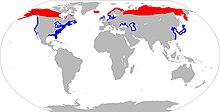| Greater scaup Temporal range:
| |
|---|---|

| |
| A. m. marila male, Northumberland, UK | |

| |
| A. m. marila female, Northumberland, UK | |
| Scientific classification | |
| Domain: | Eukaryota |
| Kingdom: | Animalia |
| Phylum: | Chordata |
| Class: | Aves |
| Order: | Anseriformes |
| Family: | Anatidae |
| Genus: | Aythya |
| Species: | A. marila
|
| Binomial name | |
| Aythya marila (Linnaeus, 1761)
| |
| Subspecies | |
|
A. m. marila (Linnaeus, 1761) | |

| |
| Range of Aythya marila | |
| Synonyms | |
|
Anas marila Linnaeus, 1761 | |
The greater scaup (Aythya marila), just scaup in Europe or, colloquially, "bluebill" in North America,[3] is a mid-sized diving duck, larger than the closely related lesser scaup and tufted duck. It spends the summer months breeding in Iceland, east across Scandinavia, northern Russia and Siberia, Alaska, and northern Canada. During the winter, it migrates south to the coasts of Europe, eastern Asia, and North America.
Drake greater scaup are larger and have more rounded heads than the females; they have a bright blue bill and yellow eyes. Their heads are dark, with a green to purple (depending on light angle) gloss; the breast is black, the belly white, the upperparts pale grey, and the wing shows a strong white stripe. The females are mostly brown, again with white on the wing. They have dull blue bills and a white patch on the face.
Greater scaup nest near water, typically on islands in northern lakes or on floating mats of vegetation. They begin breeding at age two, but start building nests in the first year. The drakes have a complex courtship, which takes place on the return migration to the summer breeding grounds and concludes with the formation of monogamous pairs. Females lay a clutch of six to nine olive-buff-coloured eggs. The eggs hatch in 24 to 28 days. The down-covered ducklings are able to follow their mother in her search for food immediately after hatching.
Greater scaup eat aquatic molluscs, plants, and insects, which they obtain by diving underwater to depths of 0.5–6 m, exceptionally 10 m.[4] They form large groups, called "rafts", that can number in the thousands. Their main threat is human development, although they are also preyed upon by owls, skunks, raccoons, foxes, coyotes, and humans. Greater scaup populations have been declining since the 1980s; however, they are still listed as a species of least concern on the IUCN Red List.[2]
- ^ Cite error: The named reference
University of Michiganwas invoked but never defined (see the help page). - ^ a b BirdLife International (2018). "Aythya marila". IUCN Red List of Threatened Species. 2018: e.T22680398A132525108. doi:10.2305/IUCN.UK.2018-2.RLTS.T22680398A132525108.en. Retrieved 11 November 2021.
- ^ Cite error: The named reference
Bluebillswas invoked but never defined (see the help page). - ^ Cramp, Stanley, ed. (1977). "Aythya marila Scaup". Handbook of the Birds of Europe the Middle East and North Africa. The Birds of the Western Palearctic. Vol. I: Ostrich to Ducks. Oxford: Oxford University Press. pp. 586–593. ISBN 978-0-19-857358-6.

